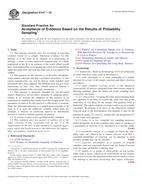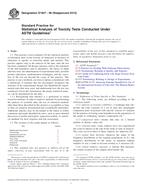Potrebujeme váš súhlas na využitie jednotlivých dát, aby sa vám okrem iného mohli ukazovať informácie týkajúce sa vašich záujmov. Súhlas udelíte kliknutím na tlačidlo „OK“.
ASTM E178-08
Standard Practice for Dealing With Outlying Observations
Automaticky preložený názov:
Štandardná prax pre riešenie odľahlých pozorovaní
NORMA vydaná dňa 1.10.2008
Informácie o norme:
Označenie normy: ASTM E178-08
Poznámka: NEPLATNÁ
Dátum vydania normy: 1.10.2008
Kód tovaru: NS-43008
Počet strán: 18
Približná hmotnosť: 54 g (0.12 libier)
Krajina: Americká technická norma
Kategória: Technické normy ASTM
Kategórie - podobné normy:
Anotácia textu normy ASTM E178-08 :
Keywords:
dixon test, gross deviation, Grubbs test, outlier, Outliers, Sampling data analysis/statistics, Statistical methods, Outliers, Sampling data analysis/statistics, Statistical methods, ICS Number Code 03.120.30 (Application of statistical methods)
Doplňujúce informácie
| 1. Scope | ||||
|
1.1 This practice covers outlying observations in samples and how to test the statistical significance of them. An outlying observation, or “outlier,” is one that appears to deviate markedly from other members of the sample in which it occurs. In this connection, the following two alternatives are of interest: 1.1.1 An outlying observation may be merely an extreme manifestation of the random variability inherent in the data. If this is true, the value should be retained and processed in the same manner as the other observations in the sample. 1.1.2 On the other hand, an outlying observation may be the result of gross deviation from prescribed experimental procedure or an error in calculating or recording the numerical value. In such cases, it may be desirable to institute an investigation to ascertain the reason for the aberrant value. The observation may even actually be rejected as a result of the investigation, though not necessarily so. At any rate, in subsequent data analysis the outlier or outliers will be recognized as probably being from a different population than that of the other sample values. 1.2 It is our purpose here to provide statistical rules that will lead the experimenter almost unerringly to look for causes of outliers when they really exist, and hence to decide whether alternative 1.1.1 above, is not the more plausible hypothesis to accept, as compared to alternative 1.1.2, in order that the most appropriate action in further data analysis may be taken. The procedures covered herein apply primarily to the simplest kind of experimental data, that is, replicate measurements of some property of a given material, or observations in a supposedly single random sample. Nevertheless, the tests suggested do cover a wide enough range of cases in practice to have broad utility. |
||||
| 2. Referenced Documents | ||||
|
Podobné normy:
Historická
1.5.2014
Historická
1.8.2011
Historická
15.5.2010
Historická
1.3.2013
Historická
1.3.2013
Historická
1.8.2011



 ASTM D7915-14
ASTM D7915-14 ASTM E122-09e1
ASTM E122-09e1 ASTM E141-10
ASTM E141-10 ASTM E1847-96(2013)..
ASTM E1847-96(2013).. ASTM E1849-96(2013)..
ASTM E1849-96(2013).. ASTM E1970-11
ASTM E1970-11
 Cookies
Cookies
